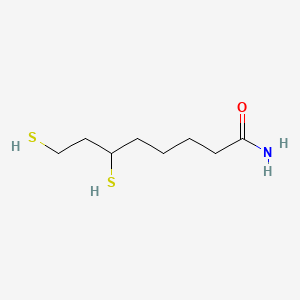| MeSH term | MeSH ID | Detail |
|---|---|---|
| Parkinsonian Disorders | D020734 | 20 associated lipids |
Dihydrolipoamide
Dihydrolipoamide is a lipid of Fatty Acyls (FA) class. Dihydrolipoamide is associated with abnormalities such as Wiskott-Aldrich Syndrome. The involved functions are known as Citric Acid Cycle, Electron Transport, NADH oxidation, Oxidation and Oxidants. Dihydrolipoamide often locates in Mitochondria, Mitochondrial matrix and Chloroplasts. The associated genes with Dihydrolipoamide are Mutant Proteins, Recombinant Proteins, mycothione reductase, Genes, Mitochondrial and alanylproline.
Cross Reference
Introduction
To understand associated biological information of Dihydrolipoamide, we collected biological information of abnormalities, associated pathways, cellular/molecular locations, biological functions, related genes/proteins, lipids and common seen animal/experimental models with organized paragraphs from literatures.
What diseases are associated with Dihydrolipoamide?
Dihydrolipoamide is suspected in and other diseases in descending order of the highest number of associated sentences.
Related references are mostly published in these journals:
| Disease | Cross reference | Weighted score | Related literature |
|---|
Possible diseases from mapped MeSH terms on references
We collected disease MeSH terms mapped to the references associated with Dihydrolipoamide
PubChem Associated disorders and diseases
What pathways are associated with Dihydrolipoamide
There are no associated biomedical information in the current reference collection.
PubChem Biomolecular Interactions and Pathways
Link to PubChem Biomolecular Interactions and PathwaysWhat cellular locations are associated with Dihydrolipoamide?
Visualization in cellular structure
Associated locations are in red color. Not associated locations are in black.
Related references are published most in these journals:
| Location | Cross reference | Weighted score | Related literatures |
|---|
What functions are associated with Dihydrolipoamide?
Related references are published most in these journals:
| Function | Cross reference | Weighted score | Related literatures |
|---|
What lipids are associated with Dihydrolipoamide?
There are no associated biomedical information in the current reference collection.
What genes are associated with Dihydrolipoamide?
Related references are published most in these journals:
| Gene | Cross reference | Weighted score | Related literatures |
|---|
What common seen animal models are associated with Dihydrolipoamide?
There are no associated biomedical information in the current reference collection.
NCBI Entrez Crosslinks
All references with Dihydrolipoamide
Download all related citations| Authors | Title | Published | Journal | PubMed Link |
|---|---|---|---|---|
| Roldán A et al. | Lipoamide dehydrogenase is essential for both bloodstream and procyclic Trypanosoma brucei. | 2011 | Mol. Microbiol. | pmid:21631607 |
| Barbieri E et al. | Morphofunctional and Biochemical Approaches for Studying Mitochondrial Changes during Myoblasts Differentiation. | 2011 | J Aging Res | pmid:21629710 |
| Kehr S et al. | Protein S-glutathionylation in malaria parasites. | 2011 | Antioxid. Redox Signal. | pmid:21595565 |
| Harvey RM et al. | A variable region within the genome of Streptococcus pneumoniae contributes to strain-strain variation in virulence. | 2011 | PLoS ONE | pmid:21573186 |
| De Britto Mari R et al. | Quantification and morphometry of myenteric neurones in the jejunum of Holtzman rats (Rattus norvegicus). | 2011 | Anat Histol Embryol | pmid:21569076 |
| pmid:21558426 | ||||
| Miller JA et al. | 1,3-Dinitrobenzene-induced metabolic impairment through selective inactivation of the pyruvate dehydrogenase complex. | 2011 | Toxicol. Sci. | pmid:21551353 |
| Li W et al. | Proteomic analysis of metabolic, cytoskeletal and stress response proteins in human heart failure. | 2012 | J. Cell. Mol. Med. | pmid:21545686 |
| Brautigam CA et al. | Structural and thermodynamic basis for weak interactions between dihydrolipoamide dehydrogenase and subunit-binding domain of the branched-chain alpha-ketoacid dehydrogenase complex. | 2011 | J. Biol. Chem. | pmid:21543315 |
| Suetsugu-Maki R et al. | A complement receptor C5a antagonist regulates epithelial to mesenchymal transition and crystallin expression after lens cataract surgery in mice. | 2011 | Mol. Vis. | pmid:21541266 |
